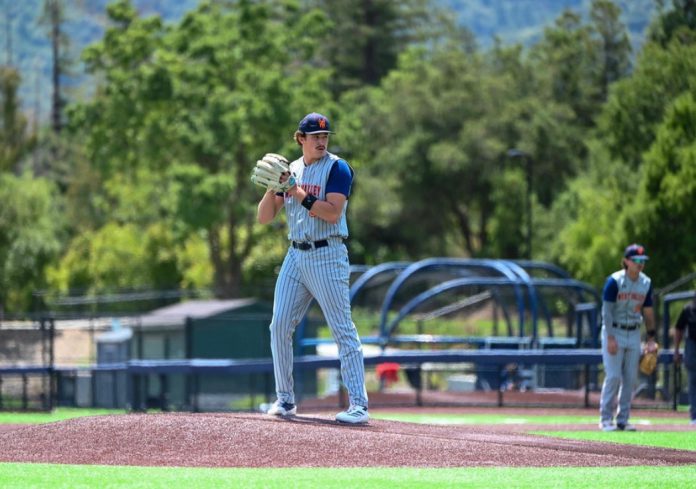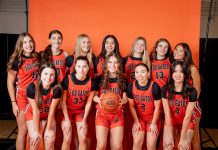The college sports landscape has changed so much in the last several years, it’s hard to keep track of all the rule-swiching and court decisions. These have sent ripples throughout the NCAA.
In last week’s Los Gatan, Camryn Whitfield detailed the Division I five-year regulation, which gives student-athletes a five-year running clock to play four seasons. In this issue, we’re highlighting two other major shifts: the impact of social media and the transfer rule. These are so significant, they’ve fundamentally altered the institution itself.
In the last five years, they’ve arguably had a greater impact on college sports than any other statute-and-medium combo in history.
A prototypical example of this came locally, when former West Valley College pitcher Nico Wagner was selected by the Atlanta Braves in the 16th round (no. 487 overall) of the Major League Baseball Draft in July.
Wagner made his only season at West Valley count, having transferred in for the 2024-2025 school year after a rough freshman season at the University of Nevada-Reno. When the 6-foot-5, 225-pound right-hander decided to enter the transfer portal after his freshman year at Nevada-Reno, he already had a slew of highlight videos on his Instagram and X (formerly Twitter) accounts. That’s exactly how West Valley coach Bobby Hill and his staff discovered Wagner was in search of a new place to play.
“When the four-year players transfer, the first place they usually hit is Twitter to let coaches know they’re available,” Hill said. “And now we’re all like the birds flipping-out for that worm.”
Wagner’s use of social media marked a dramatic turnaround from even a couple of years ago during his playing days at South Lake Tahoe High School.
“It’s unreal because everything now is done online, through Twitter, emails and videos,” Wagner said. “I was late to the party. When I was in high school, I didn’t really use any of that to get recruited. Everything was new to me.”
Social media has revolutionized recruiting, both from an accessibility and timeliness standpoint. When Wagner hit the transfer portal, Hill and Vikings’ assistant coach Kai Haake pored over Wagner’s video highlights and statistics.
Knowing Wagner had the physical skills to become a dominant pitcher again, Hill and Haake did their due diligence and called up the Nevada-Reno coaching staff to get a full scouting report on their future ace. Once everything checked out, Hill contacted Wagner, who chose to transfer to a community college instead of another four-year institution—so he could be eligible for this year’s MLB Draft.
Under the guidance of West Valley Director of Pitching Darold Brown, Wagner regained his form and confidence, leading to a dominant season that saw the Vikings advance to the California Community College State Championship game in mid-June.
A month later, Wagner got drafted, signed a contract and shortly thereafter was assigned to the Braves’ Florida Complex League rookie-level affiliate team.
“How we find these players today, everything is through Twitter and social media,” Hill said. “My coaches do a really good job of recruiting and filling in the pieces. Social media is a gamechanger for every player and program. It’s crazy.”
How crazy? Hill said he even has high school sophomores reaching out to him on his X account telling him they want to play at West Valley. A former standout player at the University of Miami who has transitioned into a successful coaching career, Hill can’t believe how fast the times have changed.
As recently as six years ago, Hill didn’t have an X account. But he vividly remembers a conversation with his former coach at Miami—the legendary Jim Morrison—which proved prescient.
“He told me back then I needed to get on Twitter because it was going to be a gamechanger,” Hill said.
The relaxing of transfer rules has also been a dynamic difference-maker in the college sports landscape. Since 2021, the NCAA has dramatically relaxed its transfer rules, moving from a system that heavily penalizes transfers to one that grants athletes significant freedom of movement.
In April 2021, the NCAA came down with a landmark decision, instituting a one-time transfer exception rule that allowed Division I athletes in all sports to transfer once and be immediately eligible to compete at a new school.
Previously, transfers in high-profile sports in football, basketball and baseball were required to sit out a year of competition. That ruling was just the tip of the iceberg. In April 2024, the NCAA instituted a decision with far-reaching reverberations, eliminating restrictions on the number of times academically-eligible student athletes can transfer during their careers without losing eligibility.
The NCAA was pressured to relax its transfer rules due to mounting legal challenges, the most significant being a lawsuit brought on by the US Department of Justice and several states in 2023.
The lawsuits alleged NCAA rules amounted to an illegal restriction on Division I athletes and the market for their labor. The relaxation of transfer rules amounted to be a seminal win for athlete empowerment, allowing them to have more freedom than ever and giving them tremendous leverage to maximize their NIL (name, image, likeness) opportunities.
A separate rule change in NCAA Division I baseball will have a dramatic impact at the community college level. Effective for the current 2025-2026 school year, Division I baseball rosters are being reduced from 40 players to 34.
“Obvously, we don’t have a crystal ball, but I believe community college baseball programs are going to be a lot better,” Hill said. “There’s a lot of buzz right now with the new rule changes at the four-year level, and I think junior college baseball is going to benefit. We’re all going to be loaded with four-year players. Before, some junior college teams had one to two four-year players. Now, junior college teams will potentially have five or more because they’ve lost scholarships due to the roster limitations, NIL money and transfer portal. It’s just a pecking order right now, and I think junior colleges benefit, believe it or not.”










